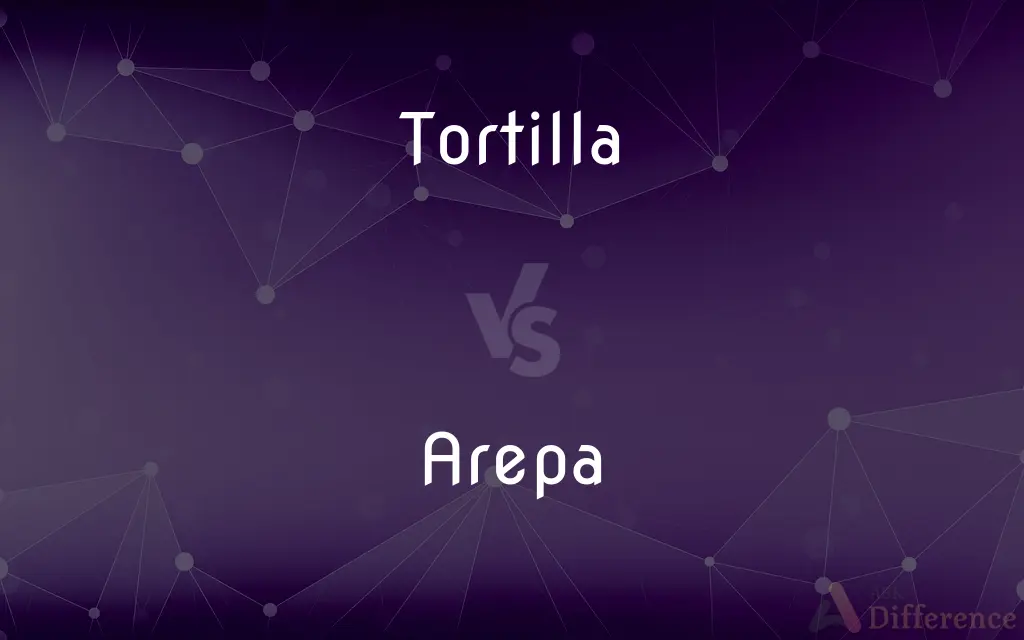Tortilla vs. Arepa — What's the Difference?
By Tayyaba Rehman & Urooj Arif — Updated on April 8, 2024
Tortillas are thin, unleavened flatbreads originating from Mexico, made primarily from corn or wheat flour. Arepas are thicker, corn-based flatbreads from Colombia and Venezuela, often split and filled.

Difference Between Tortilla and Arepa
Table of Contents
ADVERTISEMENT
Key Differences
Tortillas, a staple in Mexican cuisine, are thin, unleavened flatbreads made from corn or wheat flour, depending on the region. Whereas, arepas, originating from Colombia and Venezuela, are thicker, corn-based flatbreads that are often split and filled with various ingredients.
While tortillas are typically used as a wrap for foods like tacos, burritos, and enchiladas, arepas serve as a base or container for fillings such as cheese, meats, and beans, showcasing the different culinary traditions of Mexico and the northern part of South America.
The preparation of tortillas involves mixing the flour with water and salt, then cooking the dough on a hot surface. On the other hand, arepas are made by forming ground maize dough into patties, which are then grilled, baked, boiled, or fried, offering a variety of textures depending on the cooking method.
In terms of ingredients, tortillas can vary significantly between corn and wheat, influencing their flavor and texture. Corn tortillas are the traditional choice in Mexico, known for their distinctive taste and flexibility, while wheat tortillas are softer and larger, preferred for dishes like burritos. Arepas, however, are traditionally made from pre-cooked corn flour, leading to a unique flavor and texture that differs from both corn and wheat tortillas.
Culturally, both tortillas and arepas play significant roles in their respective cuisines, with tortillas dating back to pre-Columbian times in Mexico and arepas being a fundamental part of Colombian and Venezuelan diets, each reflecting the agricultural practices and culinary traditions of their regions.
ADVERTISEMENT
Comparison Chart
Origin
Mexico
Colombia and Venezuela
Main Ingredient
Corn or wheat flour
Pre-cooked corn flour
Thickness
Thin
Thicker
Use
Used as a wrap
Split and filled
Cooking Method
Cooked on a hot surface
Grilled, baked, boiled, or fried
Cultural Significance
Staple in Mexican cuisine, dating back to pre-Columbian times
Fundamental part of Colombian and Venezuelan diets
Compare with Definitions
Tortilla
Made from corn or wheat flour.
Wheat tortillas are preferred for making burritos due to their softness.
Arepa
A thicker, corn-based flatbread from Colombia and Venezuela.
Arepas filled with cheese and ham are a popular breakfast in Venezuela.
Tortilla
A thin, unleavened flatbread from Mexico.
Corn tortillas are essential for making authentic Mexican tacos.
Arepa
Traditionally made from pre-cooked corn flour.
Arepas are made using a special type of pre-cooked white corn flour.
Tortilla
Cooking involves pressing and heating on a hot surface.
Tortillas are quickly cooked on a hot griddle until slightly charred.
Arepa
Can be grilled, baked, boiled, or fried.
Grilled arepas develop a crispy exterior while remaining soft inside.
Tortilla
Reflects Mexican agricultural and culinary traditions.
The use of corn in tortillas dates back to pre-Columbian Mexico.
Arepa
Often split and filled with a variety of ingredients.
Arepas rellenas are split and stuffed with meats, cheeses, or beans.
Tortilla
Serves as a wrap for various dishes.
Tortillas are used to wrap ingredients in enchiladas.
Arepa
Central to Colombian and Venezuelan diets.
Arepas are a versatile food, eaten at any time of the day in Colombia and Venezuela.
Tortilla
A tortilla (, Spanish: [toɾˈtiʎa]) is a thin, flat, circular unleavened flatbread originally made from maize hominy meal, and now also from wheat flour. The Aztecs and other Nahuatl speakers called tortillas tlaxcalli ([t͡ɬaʃˈkalli]).
Arepa
Arepa (Spanish pronunciation: [aˈɾepa]) is a type of food made of ground maize dough, eaten in the northern region of South America since pre-Columbian times, and notable primarily in the cuisine of Colombia and Venezuela, but also present in the cuisines of Bolivia and other countries.It is commonly eaten in those countries and can be served with accompaniments such as cheese, cuajada (fresh cheese), various meats, chicken, avocado, or diablito (deviled ham spread). It can also be split to make sandwiches.
Tortilla
A thin disk of unleavened bread made from masa or wheat flour and baked on a hot surface.
Arepa
A baked or fried cornmeal cake of traditional Colombian cuisine.
Tortilla
(Mexican cuisine) A flat round bread made out of cornmeal or flour.
Arepa
A type of cornbread originating from the northern Andes and resembling a tortilla.
Tortilla
(Spanish cuisine) Spanish omelette; an omelette containing potatoes and onions.
Tortilla
An unleavened cake, as of maize flour, baked on a heated iron or stone.
Tortilla
Thin unleavened pancake made from cornmeal or wheat flour
Common Curiosities
How are tortillas cooked?
They are pressed and cooked on a hot surface, like a griddle.
What distinguishes an arepa from a tortilla?
Arepas are thicker, corn-based flatbreads, often split and filled, whereas tortillas are thinner and used as wraps.
Are arepas a part of both Colombian and Venezuelan cuisines?
Yes, arepas are fundamental to both Colombian and Venezuelan diets.
How does the cooking method affect an arepa's texture?
Arepas can be grilled, baked, boiled, or fried, resulting in different textures, from crispy to soft.
What is a tortilla?
A thin, unleavened flatbread from Mexico, made from corn or wheat flour.
Can tortillas be made from wheat?
Yes, tortillas can be made from either corn or wheat flour.
What is the cultural significance of tortillas in Mexico?
They are a staple food, with a history dating back to pre-Columbian times.
Is there a difference in flavor between corn and wheat tortillas?
Yes, corn tortillas have a distinctive taste and texture, while wheat tortillas are softer and larger.
What are arepas traditionally filled with?
They can be filled with a variety of ingredients, including cheese, meats, and beans.
What is the significance of the main ingredient in arepas?
Pre-cooked corn flour gives arepas their unique flavor and texture.
Can arepas be eaten at any time of the day?
Yes, arepas are versatile and can be enjoyed at any meal or as a snack.
What role do tortillas play in Mexican cuisine?
They are used in a wide variety of dishes, including tacos, burritos, and enchiladas.
How are arepas made?
By forming pre-cooked corn flour dough into patties and then cooking by grilling, baking, frying, or boiling.
How do tortillas and arepas reflect their regions' agricultural practices?
Tortillas reflect the prominence of corn in Mexico, while arepas show the adaptation of corn products in Colombia and Venezuela.
Why are wheat tortillas preferred for certain dishes?
Their softness and size make them suitable for dishes that require wrapping, like burritos.
Share Your Discovery

Previous Comparison
Gelatine vs. Isinglass
Next Comparison
Daimon vs. DaemonAuthor Spotlight
Written by
Tayyaba RehmanTayyaba Rehman is a distinguished writer, currently serving as a primary contributor to askdifference.com. As a researcher in semantics and etymology, Tayyaba's passion for the complexity of languages and their distinctions has found a perfect home on the platform. Tayyaba delves into the intricacies of language, distinguishing between commonly confused words and phrases, thereby providing clarity for readers worldwide.
Co-written by
Urooj ArifUrooj is a skilled content writer at Ask Difference, known for her exceptional ability to simplify complex topics into engaging and informative content. With a passion for research and a flair for clear, concise writing, she consistently delivers articles that resonate with our diverse audience.
















































